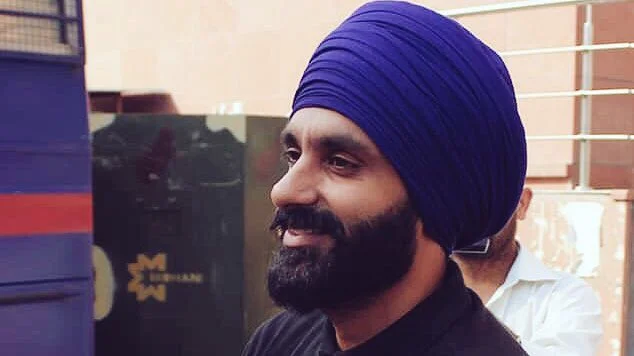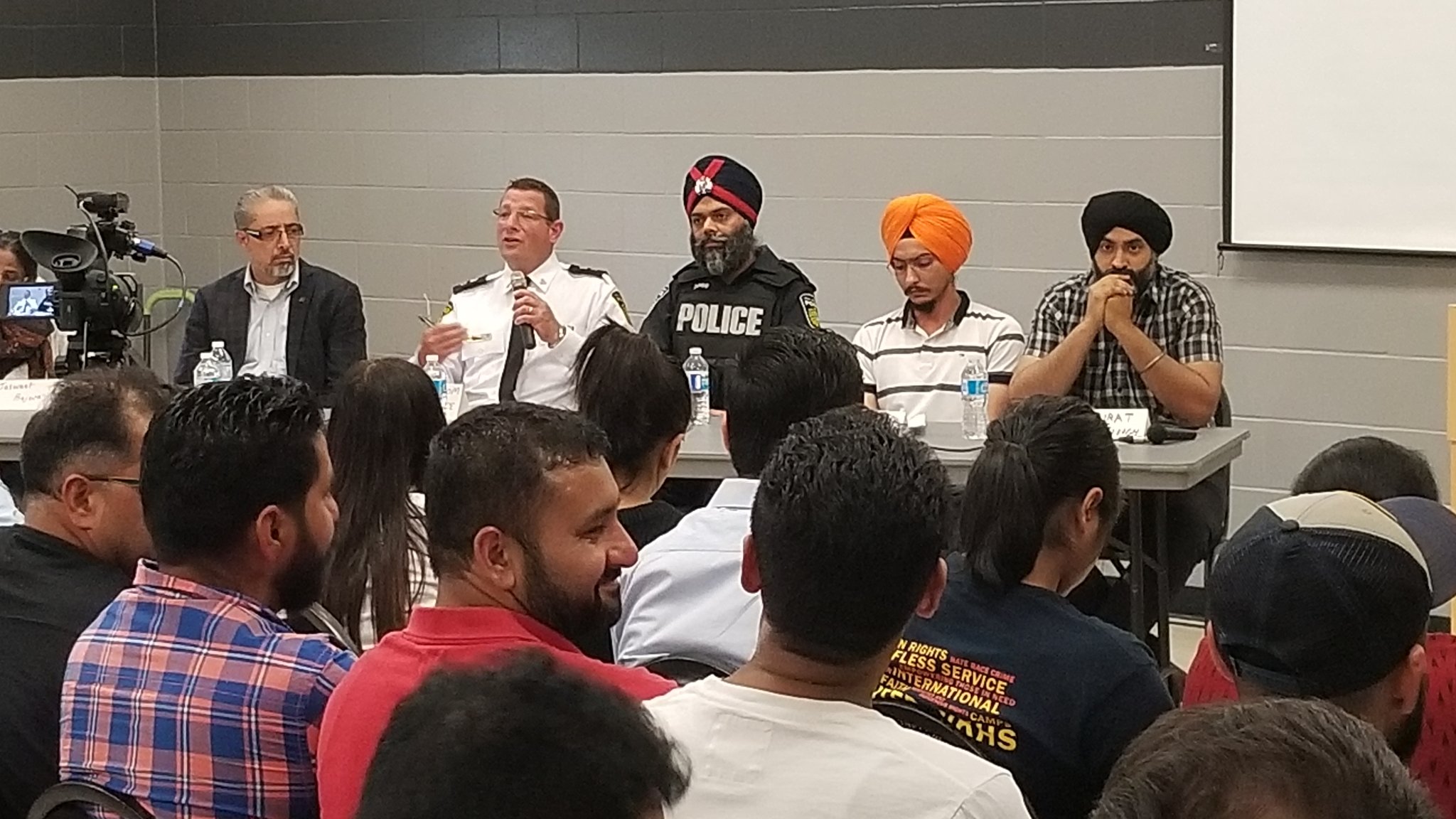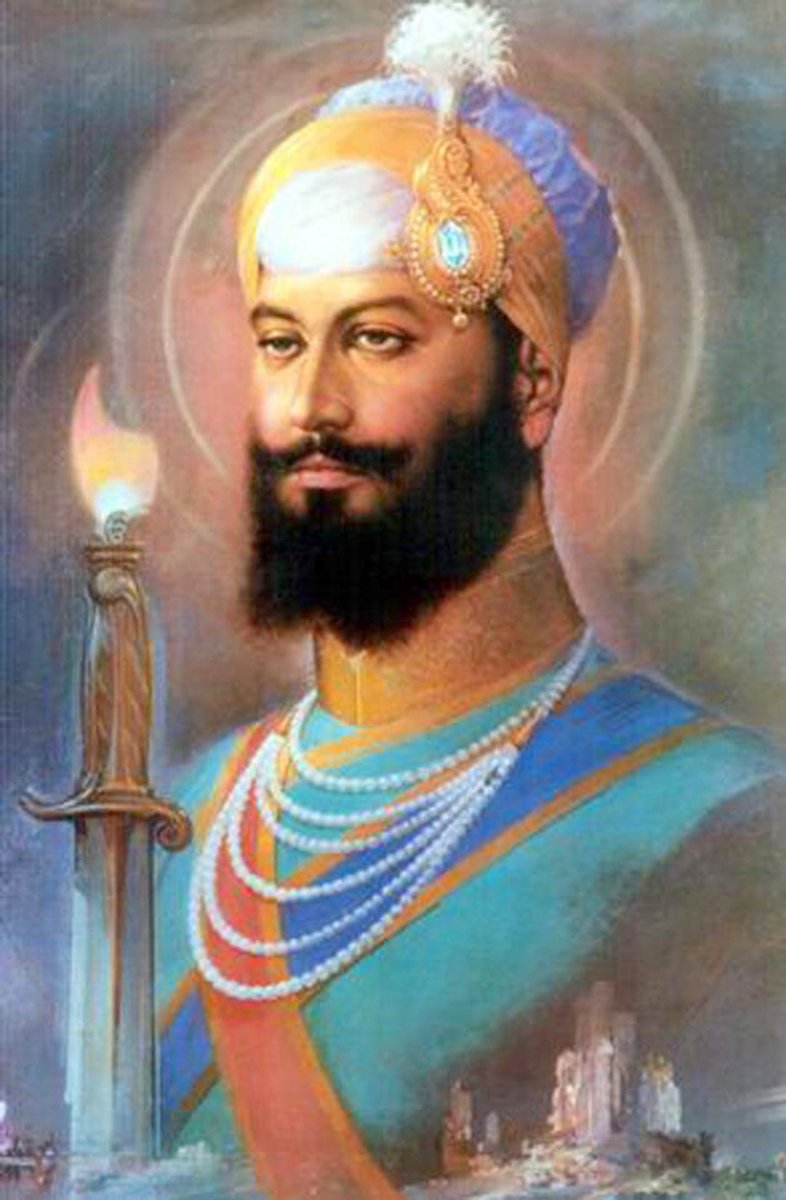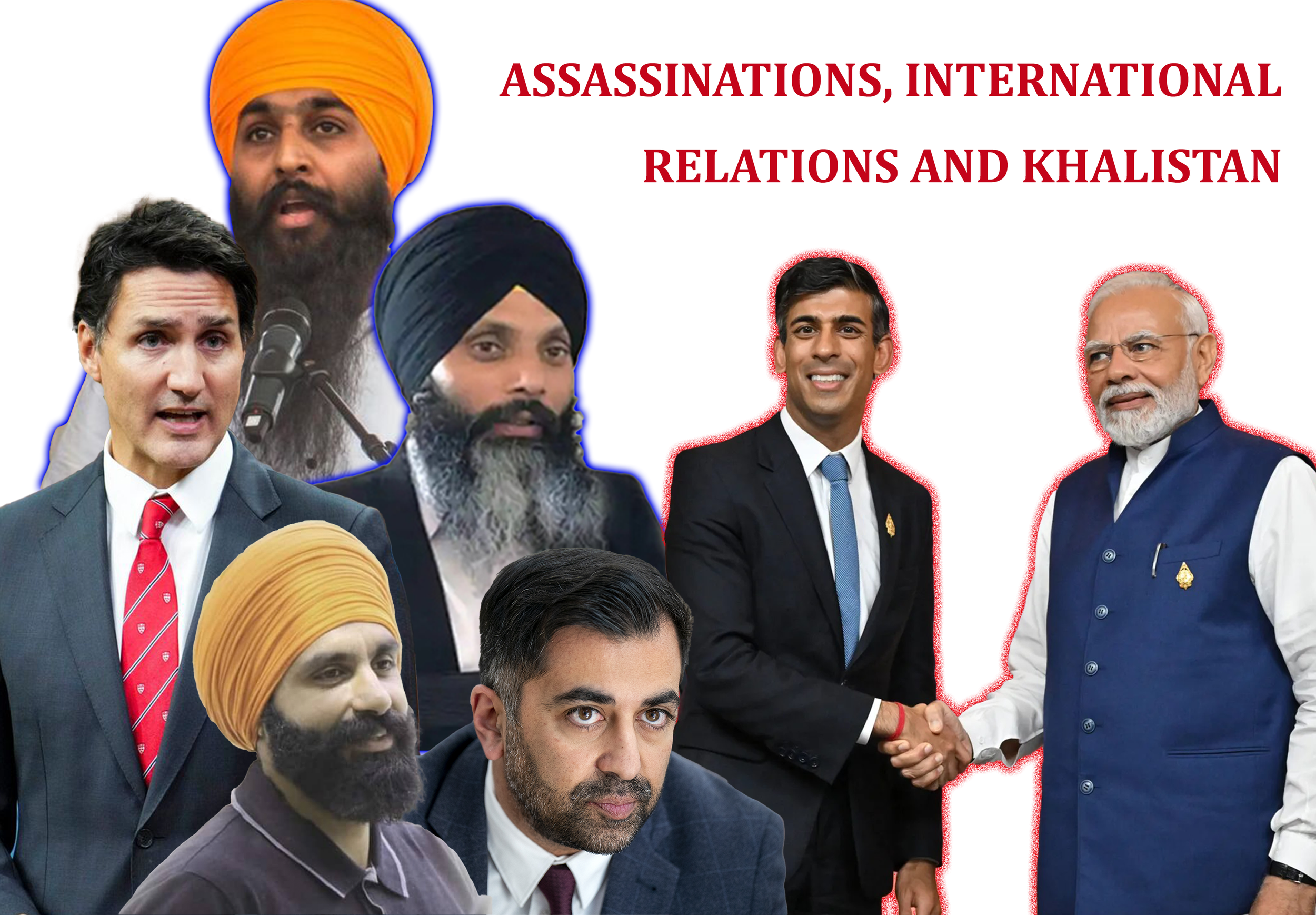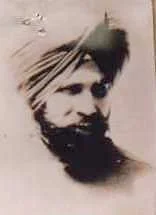The recent (illegal) arrest, detention and subsequent torture without charge of a Sikh activist and British citizen Jagtar Singh Johal,[1] referred to affectionately as Jaggi, needs to be viewed in the context of a larger struggle between the Sikh Qaum and India.
Sikhs are concerned with Jaggi’s welfare, with the threat of continued torture and the risk of an extrajudicial killing by the State. For nearly 4 decades, torture and extrajudicial killings have been the weapons of choice against Sikh activists by the Indian State, and disturbingly for Jaggi’s family and the wider Sikh Qaum, often welded together.
Since the partition of Panjab, the Sikh homeland, to create the two modern-day nation states India and Pakistan, the Sikh Qaum has been in a state of conflict with India for its existence and independence. In 1947, the tearing apart of Panjab caused 40% of the Sikh population to become homeless and almost 2.5% to be brutally massacred. Over 700 Gurudwaras, including 130 historical Gurudwaras such as Nankana Sahib and Panja Sahib, and over 70% of the fertile, irrigated and rich Punjabi land fell into Pakistan’s territory.
It was in this backdrop that the Sikh Qaum reeling from the loss of territory, both geographic and political, built from Guru Nanak to Maharaja Ranjeet Singh, began a desperate struggle for its existence. The promise of regaining the “glow of freedom”[2] upon which Sikh lives were sacrificed to liberate “India” quickly diminished with the creation of India.[3] Panjab didn’t exist and according to the Constitution of India, neither did the Sikhs.[4]
“Without a determined and grim struggle, we shall get demoralised and will disintegrate, losing our identity and perish in the dust. It would be cowardly to accept this fate. If we struggle and fall, we die a brave and noble death and if we struggle and win, we live an honourable life. So, the choice is clear”.[5]
Master Tara Singh
Sikh Leader
The Sikhs refused to sign the Constitution, and the struggle, now against India, commenced. Whilst the Sikhs threw themselves into this struggle with the same fervour as in the past, nearly a century of British Colonial rule had left its impact on the Sikh ideology and its institutions. Where “diplomatic” and “democratic” measures were given precedence over more Khalsa oriented direct action. As a result, there was much sacrifice with no result, proving to be counter-productive to the overall Sikh cause.
For example, the Akali Dal agitation for a Punjabi Suba saw over 60,000 Sikhs peacefully courted arrest. The Reorganisation Act of 1966 in response dissected Panjab further into four pieces. The major portion of its territory was ceded to Haryana and Himachal Pradesh. A sizeable chunk of its territory, about 23%, was transferred to Himachal Pradesh, while the State of Haryana secured 35.8% of the territory of the pre-organised Punjab.
The struggle continued against this latest attack on the Sikh Qaum but was lethargic and lacklustre. The next ten years only bringing about the Anandpur Sahib Resolution, a document which encapsulated the vision of the Sikhs at that time, of their aspirations for the Khalsa Bol Bala (the voice and power of the Khalsa/pre-eminence of the Khalsa).
This changed drastically with the arrival of Sant Jarnail Singh Bhindranwale in the Panthic scene, the Jathedar of the Dam Dami Taksaal appointed in August 1977. Sant Bhindranwale galvanised or “woke up the sleeping” Sikh Qaum.[6]
In August 1982, he joined the Akali led Dharam Yudh Morcha and gained even more prominence. Speaking from the Akali stage to thousands day-to-day, his passionate speeches anchored in Gurbani and rich with glorious memories of great Sikhs, such as Banda Singh Bahadhur and Baba Deep Singh, resonated with Sikhs from all walks of life. His speeches were less about the Constitutional rights of Sikhs in India, and more about Sikh ideology; the relationship between the Sikh and the Guru, and concepts of Azaadi and Ghulami, Dharam and Panth.
It was in this context, and at this time with the rise of a desire of Sikh sovereignty that the Indian Government responded with State terror to suppress the organic movement for self-determination.
Extrajudicial killings and Torture of Sikh Activists
It was during the Dharam Yudh Morcha that the Indian State, through its security forces, began to target Sikh activists. Over 190 Sikhs were killed, primarily peaceful demonstrators, during the morcha at roadblocks etc. The state also carried out targeted extrajudicial killings. The first being Shaheed Bhai Kulwant Singh Nagoke, a leading member of the Sikh resistance.[7] While the security forces had beaten and mistreated other Sikh detainees during the DYM, in Kulwant Singh Nagoke’s case the levels of depravity were exceeded, amounting to the most gruesome torture:
“From 27th May to 9th June 1982, Kulwant Singh was so brutally tortured that his bones were broken at various places; his body was torn at the hip joint by pulling his legs in opposite direction; his intestines had been taken out and both eyes had been gouged out. His nails had been pulled out. His thigh had been ripped open and salt poured into it. On 9 June ‘82 Kulwant Singh died in custody of the Police.”[8]
This became a major milestone in the Sikh struggle. The sanctioning of this treatment by the Indian State, and the Sikh response to it intensified the struggle where the only acceptable outcome now was death or Azaadi (Khalistan). While this had been the mindset of the Sikh Jujharoos, the vanguard of the struggle throughout, it was the Battle of Amritsar in June 1984 that, as prophesied by Sant Bhindranwale, laid the foundation for Khalistan in the minds and hearts of the rest of the Qaum. These sentiments were later ratified by the Sarbat Khalsa in 1986, which officially declared the decision of the Qaum to secede from India and create Khalistan.
From a small band of armed fighters, the entire Sikh Qaum was now obligated to Joojh (struggle/fight) for Khalistan. In response, the State galvanised all of its armed machinery against the Sikh Qaum. From a small concentration of senior police officers tasked with targeting and executing key Sikh activists, the entire Indian Security forces from the Army to the Police and all in-between were made aware that the target was now much wider:
“Any knowledge of Amritdharis, who are dangerous people and pledged to commit murders, arson and acts of terrorism should immediately be brought the notice of authorities. These people might appear harmless from outside but they are basically committed to terrorism. In the interest of all of us, their identity and whereabouts must always be disclosed….They have to be subdued to achieve the final aim of restoring peace in the country”[9]
Indian Army, Baatcheet (Army circular), No. 153, 1984.
Circulated to the Army following the Battle of Amritsar
The attack on Sri Darbar Sahib, Codenamed Operation Bluestar by the Indian Army, was part of a wider plan to suppress the voice and spirit of the Sikh Qaum, who had for the first time in decades began to assert its desire to be completely autonomous. Other operations by the Indian State were similarly brutal and coincided with Bluestar, including Woodrose which attempted to round up and eliminate any other Azaadi Pasand (activist) Sikh:
“The pattern in each village appears to be the same. The army moves in during the early evening, cordons a village and announces over loudspeakers that everyone must come out. All males between the age group of 15 and 35 are trussed and blindfolded, then taken away. Thousands have disappeared in the Punjab since the Army operation began.”
The Christian Science Monitor, October 15, 1984.
During this period, of the struggle for Khalistan, torture was not as prevalent as extrajudicial killings, as the State hurriedly tried to eliminate the leaders and activists of the young revolution. Clearly, the State had not taken into account Sikh history, or maybe it thought that it was just that, history:
"Manu is our sickle; we the fodder for him to mow.
The more he reaps, the more we grow."[10]
(Manu asadi datri, asi Manu de soe Jeon jeon
Manu Wad-da, asi dune chaune hoe)
Over the next decade, the full might of the Indian State including its Executive, the Judiciary, and the Legislature were employed to bring down the heights reached by the Khalistan movement. As opposed to achieving this through military might, which India possesses, the strategies which ultimately proved successful were barbaric and inhumane. Legislation like the Terrorist and Disruptive Activities (Prevention) Act 1985 legitimised the genocidal campaign against all Sikhs giving the authorities:
“Wide powers to arrest and detain without trial under vague provisions facilitate arbitrary arrests, as well as torture and other grave violations.”
Amnesty International
1 November 1994, Index number: ASA 20/039/1994
The armed movement was a popular movement backed by the masses, the Jujharoo Sikhs (armed groups) were themselves a minority. The State however directly targeted the Sikh populace at large rather than undertake any reasonable effort to engage in combating the Jujharoo Sikhs, who had occupied and controlled large areas of Panjab.
The extrajudicial killings of Sikhs were rewarded by the State, paying out tens of thousands of cash bounties to police officers simply by presenting a dead body and alleging it was a militant.
“By 1994, cases of disappearances in the state given by Human Rights Organisations were around 50,000.”
Report in Asian Age, February 8, and Pioneer, February 4, 1995
“It was a terrible tale of sadistic torture, ruthless killings, fake encounters, calculated ill-treatment of women and children, and corruption and graft on a large scale.”
Citizens For Democracy; Report To The Nation: Oppression in Punjab (Bombay, 1985).
Human rights organisations argue that the figures of Sikhs that were “disappeared” (euphemism for extrajudicial killings) were grossly understated. The State did not conduct any investigations into itself obviously, activists that took up the challenge found themselves added to the statistic.[11]
What is clear is that the main victims of state brutality were the ordinary Sikhs. Why were they targeted to stop an armed movement? The State decimated a generation of Sikhs, because they supported the goal of Khalistan, and they revered their Sikh Jujharoos who were fighting for it. The State attacked the Sikh civilian population in order to drive fear into the hearts of Sikhs. While a large number were killed, those that survived lived with the unimaginable fear of witnessing people “disappear” simply for looking as if they might support Khalistan.
Torture proved to be an effective tool for this purpose. While the Sikh Jujharoos are revered as martyrs, the ordinary citizen who was tortured lived with the scarring memory and the horrific lifelong injuries, as a permanent reminder for the others.
A Harvard Study into torture in Panjab during the Khalistan movement provides insights into the methods and objective of those who tortured:
“In virtually all cases, detainees were forced to disrobe and were then beaten with leather straps and/or wooden sticks. These acts were so common that most respondents did not even consider them acts of torture”
“…The most common form of torture, reported by (75%) of the respondents, was leg stretching. For this torture, detainees were forced to sit on the ground with their hands tied behind their backs. One police officer stood behind the detainee, pulling his or her head back by the hair, inserting his foot between the detainee's tied hands and low back while forcing his knee into the mid-back. Two other policemen, one on each side, stretched the legs as far apart as possible.”
“Electric shocks were administered using wires that touched their earlobes, genitals, toes, and fingers.”
“According to one police officer, in his police station alone, between 4,000 and 5,000 acts of torture were committed each year from 1985 to 1990.”
The overwhelming majority of the victims of torture surveyed in this report were not suspected to be combatants in the Khalistan movement by the police. These victims included both men and women and the ages ranged from 17 to 82. The report concluded that the police arrested, detained without charges, systematically tortured and killed “thousands of Sikhs who were perceived to be sympathetic to the movement”.
The levels of violence and intended trauma this caused the individuals, their immediate families and their wider communities was to strike fear into the hearts of the Sikh Qaum as a whole.
The methods in which India has treated Sikh activists, especially those who advocate Khalistan, has not changed since the 1990s. In Jagtar Singh’s case, the same methods of barbaric torture have been inflicted upon him, from beatings and stretching limbs beyond their range of motion and electric shocks administered to his earlobes, nipples and genitals.[12] The report of the torture carried out in 2017 is almost identical to the case studies of torture from Human Rights reports from the 1980s/90s (as considered earlier).
It is not that the nuclear superpower which recently launched a space mission is unable to update its torture methods, but that by utilising the same historic methods of abuse, invokes painful memories and trauma for thousands of Sikhs worldwide:
“I’ve been hiding what’s happening to Jaggi from my mom in fear of triggering the trauma she’s been through. She just found out and burst into tears. She’s shaking and begging me to stop posting things online.
My heart goes out to all the people who have PTSD from the Sikh genocide and are going through a very tough time.”
The State’s abuse and rhetoric force Sikhs to internalise the trauma and the burden of guilt, that those “dark days” were the result of us challenging the darkness (State). The dynamics and cycle of fear are complex, while the Government “cracks down” viciously on Sikh activists to strike fear; it is the Government itself that is most afraid. Often against an individual or a small number of individuals that are deemed a threat, the Government exercises all of its powers to destroy them so severely that you would be mistaken to believe they pose a serious threat to one of the largest armies in the world.
In the case of Jagtar Singh, the whole establishment from the Executive to the Judiciary has been put into action against one man. Chief Minister Captain Amrinder Singh held a press conference after Jagtar Singh’s arrest, alleging that he was involved in a series of high profile crimes and that the crimes had been solved with Jagtar’s arrest. It is extraordinary that the Chief Minister of the State would get involved in an individual case, let alone prejudice the case from the start by reporting to the world that Jagtar was guilty before charges have been made.
Then there is the Judiciary, which, in the face of complaints of serious torture is extending (currently up to 30 days) police remand without charge, to enable the torture and mistreatment in police custody. This is in addition to the Police who illegally abducted him in the manner of a kidnapping (snatched off the streets of Panjab with a sack thrown over his head), and has been torturing Jagtar Singh to obtain a false confession. They have also been harassing his family and threatening them with a similar fate, which has led to many of Jagtar Singh’s family having to go into hiding.
Jagtar Singh was targeted for his political activism, he had published websites and magazines which were anti-State and pro-Sikh. The material which has been deemed so inflammatory documented the Sikh struggle for a separate state, and the human rights abuses committed against the Sikhs in this pursuit.
His case has parallels to that of Bhai Jaswant Singh Khalra. In 1995, the Punjab police abducted, tortured, and murdered human rights activist Jaswant Singh Khalra for his work in documenting human rights abuses committed against the Sikhs during the Sikh struggle for a separate state. Khalra uncovered evidence to prove that tens of thousands of Sikhs (non-combatant) had been extrajudicially murdered, and secretly cremated by the Punjab police.
Khalra was also labelled as being a member of the Khalistan movement and additionally an agent of Pakistan’s Inter-Services Intelligence[13] by the Indian State, as Jagtar Singh has also been accused. These allegations, especially the ISI connection is designed to dehumanise and discredit Jagtar Singh and essentially justify his persecution. In the case of Jaswant Singh Khalra, these allegations were used to legitimise the abduction, torture and extrajudicial killing of the late human rights activist.
Whilst it is only natural to feel fear following the brutal persecution of Jagtar Singh and relive past traumas, we must remember these sacrifices as a contribution for the Chardi Kala of the Sikh Qaum.
The dark days are not when we are oppressed, but when we do not make a stand.
In his last speech, Jaswant Singh Khalras addressed the Sikh diaspora in Canada in a soul-stirring address, in which he exposed India’s human rights abuses to the world. Many requested Khalra to remain and claim political asylum as his life would be at risk in India. In response to his speech, he spoke of a Panjabi fable about the one lamp that challenged the darkness (oppression). The lamp, (that he, in fact, manifested himself), would challenge the darkness from setting, even if only around that lamp. He said that the lamp was then joined by other lamps until the darkness was overcome.
Jagtar Singh is one of the other lamps Khalra spoke about. The light that Jagtar Singh’s case has shed on Sikh human rights issues, by first becoming an example himself, and then through the global #FreeJaggiNow campaign is clear. There have been others before them, and there must be more now also, to continue this challenge, to the darkness.
Excerpts from Jaswant Singh Khalra’s last speech in Ontario (1995)
There is a fable that when the Sun was setting for the first time, and it was completing its journey, Light was decreasing. The light was decreasing, and the signs of Darkness were appearing.
It is said that lamentation was rife among the people – that the Sun will set, Darkness will spread, and no one will be able to see anything. “What will happen to us?” Everybody was worried, but the Sunset.
In order to show its strength, Darkness set its foot on the Earth. But far away, in some hut, one little Lamp lifted his head.
It proclaimed “I challenge the Darkness. If nothing else, then at least around myself. I will not let it settle. Around myself, I will establish Light.”
Watching that one Lamp, in other huts, other lamps arose. And the world was amazed that these lamps stopped Darkness from expanding so that people could see.
I believe that today, when Darkness is trying to overwhelm Truth with full strength, then if no one else, Ankhila (proud) Punjab, like a Lamp, is challenging this Darkness.
And I pray to the Guru, who identifies with Truth, to keep this light lit.
….
We ask the Guru for everything, but afraid, we don't ask the Guru for that one gift. The Guru has many gifts, but what is the greatest gift the Guru has?
That special gift -- which the Guru possesses -- is the gift of martyrdom.
Those who receive this gift -- they don't get to be Guru. But after the Guru, they are the most respected people of our Sikh nation.
I have hope. I am not a political leader who plays politics. I will definitely say this to you:
The Khalsa was inaugurated to protect the human rights of the world.
If you cannot protect your own human rights, you will not be able to give any sense of the Khalsa to the world.
I ask that you please don't learn how to just take from the Guru. Also learn how to fulfill the instructions given to you by the Guru.
That will encompass everything. You will obtain all joys.
With these remarks, please join in me the victorious greeting: Waheguru Ji Ka Khalsa, Sri Waheguru Ji Ki Fateh (“The Khalsa belongs to the Waheguru, and all victory belongs to Waheguru”)
Dhan Guru, Dhan Guru Piyaarai
Parnaam Sada Shaheeda Nu
Khalistan Zindabad!
Baljit Singh
[1] Jagtar Singh Johal (Jaggi), a 31 year old British national was abducted of the streets of Panjab on 4th November 2017. At the time of writing Jagtar has been in detention for over 20 days without charge.
[2] "...the brave Sikhs of Punjab are entitled to special considerations. I see nothing wrong in an area set up in the North of India wherein, the Sikhs can also experience the glow of freedom." (Jawahar Lal Nehru, Lahore Bulletin, January 9, 1930)
[3] "...in future, the Congress shall accept no constitution which does not meet with the satisfaction of the Sikhs" (The Lahore session of the Congress Party. December 31, 1929)
[4] Sikhs are not recognised in the Constitution; Article 25 of the Indian Constitution, refers to Sikhs as being a part of the Hindu faith.
[5] Partap Singh; Biography of S. Hukam Singh (New Delhi, 1989), P52.
[6] Reference to the popular maxim; “Bhindranwale Sant Sipahi, Jihna Suthi Kaum Jugaee”, (Bhindranwale the Saint Soldier who awoken the Sleeping Sikh Qaum).
[7] See Game of Love page, Akaal Publishers p136
[8] S.S. Dharam; The Only Option For Sikhs (Jaipur, 1984), P. 109
[9] Indian Army, Baatcheet (Army circular), No. 153, 1984
[10] Legendary folk saying among the Sikhs during the time when Mir Mannu was the governor of Lahore during the period 1748-53 AD. Sikhs had organized themselves into the Dal Khalsa. Mannu responded with indiscriminate killings and persecution of Sikhs during his reign.
[11] The late Jaswant Singh Khalra is testament to this; a Sikh human rights activist who was himself killed by the Indian security forces for documenting their extra judicial killings of Sikhs. For more information on Jaswant Singh Khalra and his work: http://www.ensaaf.org/publications/reports/protectingthekillers/
[12] Advocate Jaspal Singh Manjhpur, Jagtar Singh’s lawyer has confirmed reports of torture are true; https://sikhsiyasat.net/2017/11/15/relative-lawyer-jagtar-singh-jaggi-uk-updates-arrest-detention-torture-video-update/
[13] Human Rights Watch, Protecting the Killers, A Policy of Impunity in Punjab, India (paragraphs 40-45)
[1] Jagtar Singh Johal (Jaggi), a 31 year old British national was abducted of the streets of Panjab on 4th November 2017. At the time of writing Jagtar has been in detention for over 20 days without charge.
[2] "...the brave Sikhs of Punjab are entitled to special considerations. I see nothing wrong in an area set up in the North of India wherein, the Sikhs can also experience the glow of freedom." (Jawahar Lal Nehru, Lahore Bulletin, January 9, 1930)
[3] "...in future, the Congress shall accept no constitution which does not meet with the satisfaction of the Sikhs" (The Lahore session of the Congress Party. December 31, 1929)
[4] Sikhs are not recognised in the Constitution; Article 25 of the Indian Constitution, refers to Sikhs as being a part of the Hindu faith.
[5] Partap Singh; Biography of S. Hukam Singh (New Delhi, 1989), P52.
[6] Reference to the popular maxim; “Bhindranwale Sant Sipahi, Jihna Suthi Kaum Jugaee”, (Bhindranwale the Saint Soldier who awoken the Sleeping Sikh Qaum).
[7] See Game of Love page, Akaal Publishers p136
[8] S.S. Dharam; The Only Option For Sikhs (Jaipur, 1984), P. 109
[9] Indian Army, Baatcheet (Army circular), No. 153, 1984
[10] Legendary folk saying among the Sikhs during the time when Mir Mannu was the governor of Lahore during the period 1748-53 AD. Sikhs had organized themselves into the Dal Khalsa. Mannu responded with indiscriminate killings and persecution of Sikhs during his reign.
[12] The late Jaswant Singh Khalra is testament to this; a Sikh human rights activist who was himself killed by the Indian security forces for documenting their extra judicial killings of Sikhs. For more information on Jaswant Singh Khalra and his work: http://www.ensaaf.org/publications/reports/protectingthekillers/
[13] Advocate Jaspal Singh Manjhpur, Jagtar Singh’s lawyer has confirmed reports of torture are true; https://sikhsiyasat.net/2017/11/15/relative-lawyer-jagtar-singh-jaggi-uk-updates-arrest-detention-torture-video-update/
[14] Human Rights Watch, Protecting the Killers, A Policy of Impunity in Punjab, India (paragraphs 40-45)



